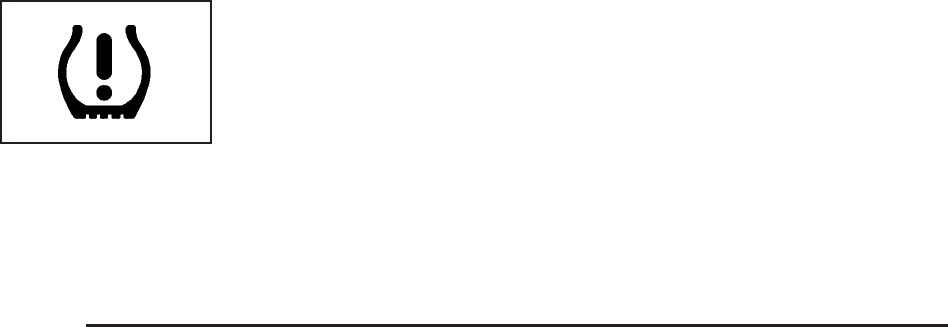
Tire Pressure Monitor System
If your vehicle has this feature, it is designed to alert
you when the system detects a large change in
the pressure of one tire. The system cannot alert you
before you drive that a tire is low or flat. You must begin
driving before the system will work properly. The
system works with the brake control system and is
designed to detect differences in the tire rotation speeds
that are caused by changes in tire pressure. The tire
pressure monitoring system does not replace normal tire
maintenance, see Tires on page 5-52, Tire Inspection
and Rotation on page 5-62 and When It Is Time for New
Tires on page 5-64.
This light, on the
instrument panel cluster,
comes on when the
tire pressure monitoring
system detects a low-tire
condition.
This light will also come on for a few seconds and then
go off when you turn the ignition to ON. This indicates
that the tire pressure monitoring system is functioning
properly. If the low-tire pressure warning light comes on
while driving your vehicle, the system may have
detected a low-tire condition. You need to stop as soon
as possible and check your tires for damage. If a tire
is flat, see If a Tire Goes Flat on page 5-69 and
Changing a Flat Tire on page 5-70. Also check the
tire pressure in all four tires, and set them to the
specified level shown on the tire and loading label.
See Inflation - Tire Pressure on page 5-58 for
additional information.
Note: The tire pressure monitoring system on your
vehicle will warn you when one of your tires is
significantly under-inflated and when some combinations
of your tires are significantly under-inflated. However,
there are other combinations of significantly
under-inflated tires for which your tire pressure
monitoring system may not warn you. These other
combinations are relatively common, accounting
for approximately half the instances in which vehicles
have significantly under-inflated tires. For example, your
system may not warn you when both tires on the
same side or on the same axle of your vehicle are
significantly under-inflated. It is particularly important,
therefore, for you to check the tire pressure in all of your
tires regularly and maintain proper pressure.
In order for the tire pressure monitoring system to work
properly you will need to reset (initialize) the tire
pressure monitoring system. Any time you check and/or
adjust a tire’s pressure, repair or replace a tire or
wheel or rotate the tires the tire pressure monitor system
needs to be reset.
5-60


















